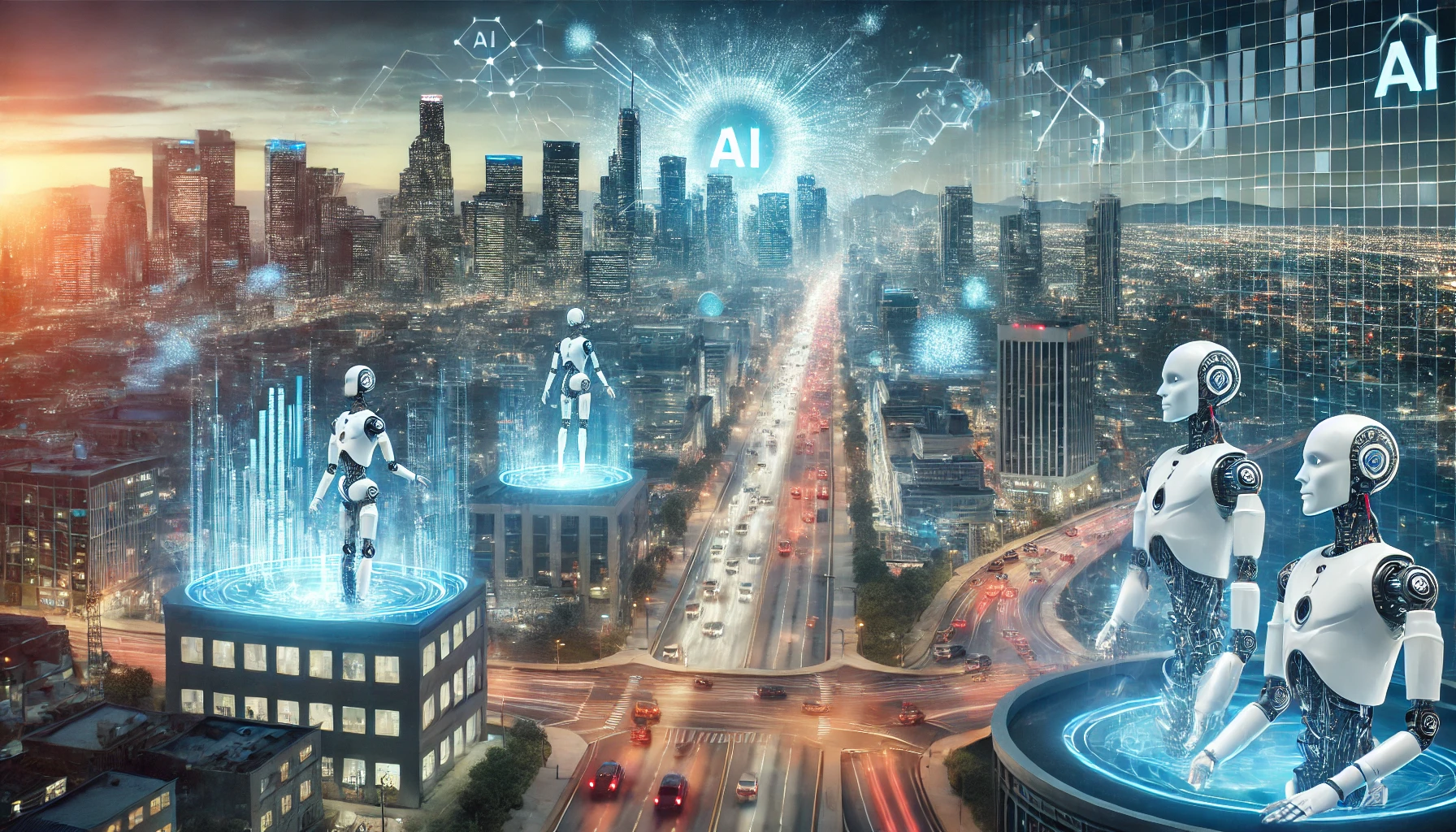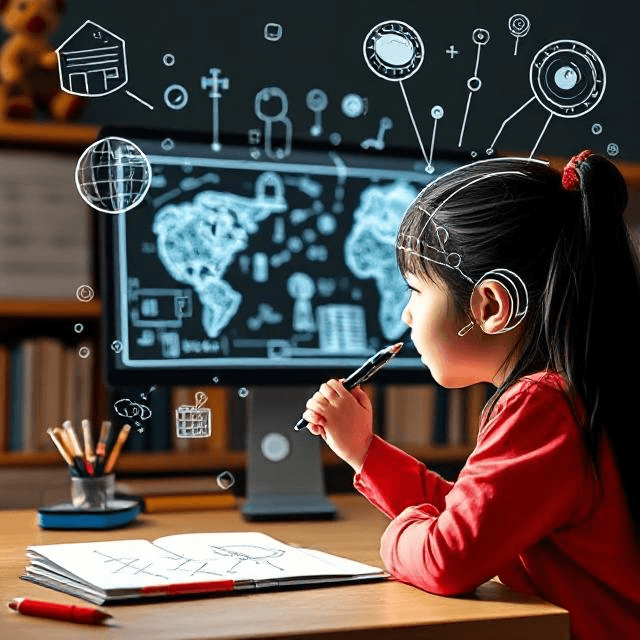AI Revolution Unveiled: How Artificial Intelligence Shapes America’s Future

Key Points
- Research suggests AI is significantly boosting the U.S. economy, contributing 16%–20% of GDP growth in 2024, with projections of trillions added by 2030.
- It seems likely that AI is transforming healthcare with better diagnostics, transportation with semi-autonomous vehicles, and education with personalized learning, though challenges like equity and privacy remain.
- The evidence leans toward AI enhancing cybersecurity but also enabling advanced cyber threats, with ongoing debates on ethics and regulations at federal and state levels.
- America appears to lead in AI innovation, supported by major investments and research, though global competition, especially with China, adds complexity.
Economic Impact
Artificial Intelligence is driving economic growth in the U.S., with recent data showing it contributed 16%–20% of real GDP growth in 2024, a trend expected to grow in 2025 NBC News: AI investments are powering more of the American economy. Projections suggest AI could add trillions to the economy by 2030, with estimates like PwC forecasting a 14.5% GDP boost for North America PwC’s Global Artificial Intelligence Study. This growth is fueled by massive investments, such as Amazon’s $11 billion in Georgia and Microsoft’s $80 billion on AI-enabled data centers NBC News: AI investments are powering more of the American economy.
AI is also reshaping jobs, automating routine tasks while creating new roles in AI development and data science. Programs like the National AI Initiative are helping upskill workers, but there’s debate over job displacement, especially in white-collar sectors where software engineering postings are below pre-pandemic levels NBC News: AI investments are powering more of the American economy.
Sector Transformations
In healthcare, AI is improving diagnostics, with models like those from Microsoft and Mayo Clinic enhancing radiology analysis for faster, more accurate diagnoses Microsoft: 2 AI breakthroughs unlock new potential for health and science. It’s also expanding telemedicine, particularly in rural areas, though challenges like data privacy under HIPAA persist.
In transportation, semi-autonomous vehicles are advancing, with systems like Tesla’s Autopilot and Waymo’s self-driving taxis in select cities. By 2025, more cars may offer highway pilot features, reducing driver fatigue, but fully autonomous driving is still years away McKinsey: The future of autonomous vehicles.
In education, AI personalizes learning through tools like ChatGPT, used by 89% of students for homework, and helps teachers with lesson planning EdTech Magazine: AI in Education in 2024. However, ensuring equitable access is crucial, as the digital divide could leave some students behind.
Governance and Ethics
AI’s role in security is dual-edged: it boosts cybersecurity with real-time threat detection, but attackers use it for sophisticated phishing, creating an arms race SecurityWeek: Cyber Insights 2025: Artificial Intelligence. Military applications, like autonomous drones, are also advancing, raising ethical questions.
On ethics, bias in AI systems, such as in criminal justice, is a concern, with calls for transparency and accountability to ensure fairness Software Improvement Group: AI legislation in the US: A 2025 overview. This is a debated area, with differing views on how to balance innovation and equity.
Public policy is evolving, with federal regulations under review and states like California leading with laws on AI transparency Software Improvement Group: AI legislation in the US: A 2025 overview. The U.S. AI Bill of Rights remains a reference, but implementation varies, reflecting ongoing discussions on regulation.
Future Outlook
Emerging trends include AI co-scientists accelerating research, like Google’s work on scientific discovery Google Research: Accelerating scientific breakthroughs with an AI co-scientist, and applications in healthcare and logistics. The U.S. leads with investments like Apple’s $500 billion plan and initiatives like NSF’s AI Research Institutes, but faces competition from China, adding complexity to global leadership Ironhack Blog: Artificial Intelligence Breakthroughs: Key Developments to Expect in 2025.
Report: Detailed Analysis of AI’s Impact on America’s Future
This report provides a comprehensive examination of how Artificial Intelligence (AI) is shaping America’s future, covering economic impacts, sectoral transformations, governance challenges, and emerging trends. The analysis is grounded in recent data and projections, ensuring relevance for March 2025, and aims to offer insights for a general audience interested in science and technology.
Economic Impact: Driving Growth and Job Shifts
AI is a significant driver of economic growth in the U.S., with recent analyses indicating it contributed 16%–20% of real GDP growth in Q3 2024, expected to grow further in 2025 NBC News: The robots haven’t taken over yet, but AI investments are powering more of the American economy. This surge is supported by substantial investments, as evidenced by:
| Company | Investment Amount | Details |
|---|---|---|
| Amazon AWS | $11 billion | Investment in Georgia for AI and cloud infrastructure NBC News |
| Microsoft | $80 billion | Planned spending on AI-enabled data centers for fiscal 2025 NBC News |
| Softbank | $100 billion | AI-related spending in the U.S., announced in early 2025 NBC News |
| Apple | $500 billion (over 4 years) | Includes AI server factory in Texas and 20,000 R&D jobs Crescendo AI: Latest AI Breakthroughs and News: Feb-March 2025 |
Projections vary, with PwC estimating a 14.5% GDP boost for North America by 2030, translating to significant economic value PwC’s Global Artificial Intelligence Study, and IDC predicting AI will drive 3.5% of global GDP in 2030, with a cumulative impact of $19.9 trillion IDC: Artificial Intelligence Will Contribute $19.9 Trillion to the Global Economy through 2030. Goldman Sachs offers a more modest forecast, adding 0.4 percentage points to U.S. GDP growth by 2034 Goldman Sachs: AI may start to boost US GDP in 2027.
The job market is undergoing transformation, with automation replacing routine tasks like data entry, while new roles emerge in AI and data science. The construction sector sees healthy job growth over 2.5% annually, driven by data center builds, but white-collar jobs, particularly software engineering, are stagnant, with postings below pre-pandemic levels NBC News: The robots haven’t taken over yet, but AI investments are powering more of the American economy. This shift highlights the need for upskilling, supported by initiatives like the National AI Initiative.
Sectoral Transformations: Healthcare, Transportation, and Education
AI is revolutionizing key sectors, each with unique applications and challenges.
- Healthcare: AI enhances diagnostics, with 79% of organizations using it by 2024, realizing a $3.20 return per $1 invested within 14 months Grand View Research: AI In Healthcare Market Size, Share & Growth Report, 2030. Recent breakthroughs include Microsoft and Mayo Clinic’s multimodal models for radiology, improving diagnostic speed and accuracy Microsoft: 2 AI breakthroughs unlock new potential for health and science, and Mount Sinai’s center combining AI with genomics Healthcare Innovation: Peering Into 2025: Will Next Year Be AI’s Huge Breakthrough Year?. Telemedicine expands access, especially in rural areas, but data privacy under HIPAA remains a challenge.
- Transportation: Autonomous vehicles are advancing, with McKinsey predicting L3 and L4 systems for highways will be common by 2025 in North America McKinsey: The future of autonomous vehicles. Goldman Sachs forecasts 10% of new car sales could be Level 3 by 2030 Goldman Sachs: Partially autonomous cars forecast to comprise 10% of new vehicle sales by 2030. Companies like Tesla and Waymo are expanding, with Waymo operating self-driving taxis in select cities, but full autonomy is still years away, limited by regulatory and technological hurdles.
- Education: AI personalizes learning, with 89% of students using ChatGPT for homework and 50% of teachers using AI for lesson planning ArtSmart AI: AI in Education: 2025 Statistics & the Future of Learning. Platforms like Carnegie Learning adapt to student needs, and AI automates grading and scheduling. However, the digital divide poses risks, with UNESCO emphasizing equitable access UNESCO: Artificial intelligence in education. The Annual AI+Education Summit 2025 at Stanford highlighted AI’s role in bridging educational divides Inside Higher Ed: AI and education: Shaping the future before it shapes us.
Governance and Ethics: Balancing Innovation and Responsibility
AI’s integration into security, ethics, and policy presents both opportunities and challenges.
- Security: AI enhances cybersecurity with real-time threat detection, analyzing massive datasets for anomalies SC Media: 2025 Forecast: AI to supercharge attacks, quantum threats grow, SaaS security woes. Companies like Darktrace use AI for this purpose, but attackers leverage AI for personalized phishing, creating an escalating arms race ZDNET: Navigating AI-powered cyber threats in 2025: 4 expert security tips for businesses. Military applications, such as autonomous drones, are advancing, raising ethical debates on use and oversight.
- Ethics: Bias in AI systems is a major concern, with examples like the COMPAS system in criminal justice showing potential for unfair treatment Software Improvement Group: AI legislation in the US: A 2025 overview. Transparency and accountability are debated, with calls for AI systems to be explainable and fair, reflecting differing views on balancing innovation and equity.
- Public Policy: Federal regulation is lighter under the Trump administration, with some Biden-era executive orders revoked, focusing on removing barriers to AI innovation SIG: AI legislation in the US: A 2025 overview. States are stepping in, with California’s CCPA draft regulations on AI transparency effective by 2026 BCLP: US state-by-state AI legislation snapshot. The U.S. AI Bill of Rights remains a reference, but implementation varies, highlighting ongoing regulatory debates.
Future Outlook: Emerging Trends and U.S. Leadership
Emerging trends underscore America’s AI leadership, with recent breakthroughs and strategic initiatives.
- Breakthroughs: AI co-scientists, like Google’s system using Gemini 2.0, accelerate scientific discovery by generating hypotheses Google Research: Accelerating scientific breakthroughs with an AI co-scientist. Healthcare sees AI models for radiology and drug discovery, while logistics benefits from AI-driven route optimization Ironhack Blog: Artificial Intelligence Breakthroughs: Key Developments to Expect in 2025. Apple’s $500 billion investment plan, including an AI server factory, highlights U.S. commitment Crescendo AI: Latest AI Breakthroughs and News: Feb-March 2025.
- U.S. Leadership: The U.S. leads with investments and research, supported by NSF’s AI Research Institutes and immigration policies attracting global talent. However, global competition, particularly with China, is intense, with China projected to see a 26.1% GDP boost from AI by 2030 Statista: Worldwide: projected AI contribution to GDP by region 2030. This competition adds complexity, with the U.S. focusing on STEM education and public-private partnerships to maintain its edge.
This report provides a detailed, data-driven overview, ensuring readers understand AI’s multifaceted impact on America’s future as of March 2025.
Key Citations
- PwC’s Global Artificial Intelligence Study: Sizing the prize
- IDC: Artificial Intelligence Will Contribute $19.9 Trillion to the Global Economy through 2030 and Drive 3.5% of Global GDP in 2030
- NBC News: The robots haven’t taken over yet, but AI investments are powering more of the American economy
- HealthTech Magazine: An Overview of 2025 AI Trends in Healthcare
- McKinsey: The future of autonomous vehicles: Convenient and connected
- EdTech Magazine: AI in Education in 2024: Educators Express Mixed Feelings on the Technology’s Future
- SecurityWeek: Cyber Insights 2025: Artificial Intelligence
- Software Improvement Group: AI legislation in the US: A 2025 overview
- Ironhack Blog: Artificial Intelligence Breakthroughs: Key Developments to Expect in 2025
- Microsoft: 2 AI breakthroughs unlock new potential for health and science
- Google Research: Accelerating scientific breakthroughs with an AI co-scientist
- Goldman Sachs: AI may start to boost US GDP in 2027
- Goldman Sachs: Partially autonomous cars forecast to comprise 10% of new vehicle sales by 2030
- ArtSmart AI: AI in Education: 2025 Statistics & the Future of Learning
- UNESCO: Artificial intelligence in education
- Inside Higher Ed: AI and education: Shaping the future before it shapes us
- SC Media: 2025 Forecast: AI to supercharge attacks, quantum threats grow, SaaS security woes
- ZDNET: Navigating AI-powered cyber threats in 2025: 4 expert security tips for businesses
- BCLP: US state-by-state AI legislation snapshot
- Statista: Worldwide: projected AI contribution to GDP by region 2030
- Grand View Research: AI In Healthcare Market Size, Share & Growth Report, 2030
- Healthcare Innovation: Peering Into 2025: Will Next Year Be AI’s Huge Breakthrough Year?
- Crescendo AI: Latest AI Breakthroughs and News: Feb-March 2025




